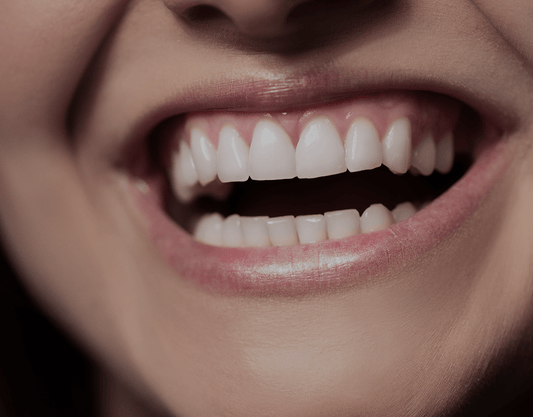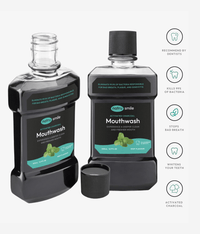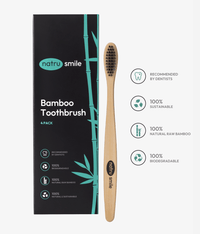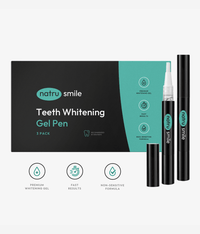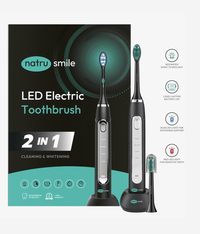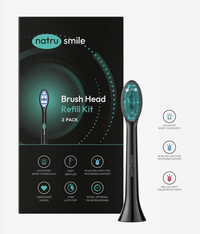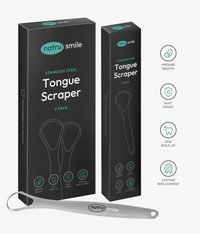
All products are certified by dental expert Dr. Greg Grillo
Tooth enamel is responsible for protecting our teeth from damage, decay, and discoloration. It's made up of a hard mineral called hydroxyapatite and is composed of calcium phosphate crystals. It is very strong and resilient, making it capable of withstanding many different types of wear and tear.
Still, it is susceptible to damage and can become weakened or eroded over time. And if that happens, your teeth become more vulnerable to decay and discoloration.
The good news is that there are steps you can take to help strengthen and repair your tooth enamel. This article tells you everything you need to know about how to do just that.
Tooth Enamel Erosion: A Quick Overview
Tooth enamel erosion is a condition that occurs when the protective layer of enamel on your teeth erodes away, exposing your teeth to damage.
Enamel erosion can be caused by a variety of factors, including foods and drinks that damage teeth, dry mouth, genetics, and certain medications. It can also result from smoking and using tobacco products.
The most common symptom of enamel erosion is sensitivity or pain in the teeth due to the lack of protection. You may also experience discoloration of the teeth, which may appear yellow or darker than normal.
Over time, deeper grooves and pits in the teeth can occur—as well as cracked or broken teeth—due to weak enamel.
Why Is Tooth Enamel Important?
If someone has ever told you that tooth enamel is the hardest substance in the body, they would be correct. It is made up of hydroxyapatite, a hard mineral that’s composed of calcium phosphate crystals.
This strong, resilient layer protects your teeth from several damaging factors:
- Tooth decay and damage
- Acid erosion from foods and drinks
- Bacteria growth
- Temperature changes
- Staining from dark-colored foods and drinks
It also helps keep your teeth looking their best, as it is responsible for giving them a white hue.
If it becomes weakened or eroded due to poor oral hygiene habits or other factors, your teeth are more vulnerable to decay, discoloration, and other forms of damage.
This might not sound important at first, but your enamel is actually the first line of defense against tooth decay and other oral health issues. Without it, your teeth are much more likely to become damaged or decayed.
Symptoms Of Enamel Erosion
If your tooth enamel is starting to erode, there will usually be a few signs that will alert you to this.
The most common symptom is increased tooth sensitivity or pain when exposed to cold, sugary, or acidic foods and drinks. You may also notice a discoloration of your teeth – it could be yellow or even darker than normal.
Let's take a look at some other symptoms that could indicate enamel erosion:
Discoloration Or Yellowing Of The Teeth
Discoloration is generally caused by poor lifestyle choices, such as eating the wrong foods, drinking too many soft drinks, or smoking cigarettes habitually. Some medications—such as tetracycline—can also cause discoloration.
If you see tooth discoloration or stains, this could mean several things—and it doesn't necessarily indicate enamel erosion. But if the discoloration is accompanied by other symptoms (like increased sensitivity or pain), then this could point to enamel erosion being the cause.
Deep Grooves And Pits In The Teeth
If you look closely at your teeth, you may notice deep grooves or pits that weren't there before. They usually look like tiny craters, and they often occur around the edges of your teeth.
This is usually a sign that enamel erosion has begun to occur. If the buildup of plaque, bacteria, and tartar in your mouth has started to eat into your enamel, these grooves and pits will start to form.
Increased Tooth Sensitivity Or Pain
When exposed to hot, cold, sugary, or acidic foods and drinks, you may experience an increased level of sensitivity or pain in your teeth.
Teeth sensitivity after dental cleaning is normal, but weakened and exposed enamel is usually sensitive to a variety of other things.
If you find yourself in pain when eating hot or cold foods, it's important to remember that around 14% (give or take) of the population suffers from tooth sensitivity—you may be in the same boat.
But if your sensitivity seems to have come out of nowhere or has gotten worse over time, enamel erosion could be the culprit.
Black Dots On Teeth
If you have black dots on your teeth, this means that your enamel is becoming softer and more prone to cracking or breaking.
These spots are usually a sign of advanced decay, meaning your enamel has already been weakened and worn down significantly.
Most people notice one of the above side effects before noticing something like black dots. Typically, they are a result of neglecting to take care of your teeth.
Cracked Or Broken Teeth
When your enamel wears down, it becomes more brittle and prone to cracking or breaking. It's not unusual for people with weakened enamel to experience a cracked or broken tooth.
This could be due to trauma, such as eating something hard, or it could just be from the natural wear and tear of daily life.
In some cases, even biting into something soft or clenching your jaw too tightly can cause a cracked or broken tooth.
In any case, it's important to get your teeth fixed as soon as possible—otherwise, they'll only become weaker and more fragile.
Worn Edges On The Back Teeth
Your back teeth are usually the first to show noticeable damage. Since they're harder to reach, some people miss them altogether, even if they brush and floss regularly.
Look for signs of wear on your back teeth, such as rounded edges or a smooth surface. This is usually an indication that the enamel has become thinned out from erosion.
You may also feel pain when chewing or biting down. This is because the exposed dentin is more sensitive than enamel.
Visible Gaps Between Teeth
Gaps between your teeth can occur when enamel erosion happens. The gaps usually form as the teeth start to move away from each other due to the weakened enamel.
Preexisting gaps aren't a cause for concern, but if you notice them getting bigger over time, it's probably because the enamel is wearing down.
11 Causes Of Tooth Enamel Erosion
The best way to prevent tooth enamel erosion is to know the causes. That way, you can understand your risk and work to reduce it.
Here are some of the most common causes of tooth enamel erosion:
1. Chronic Dry Mouth (Xerostomia)
Xerostomia, also known as dry mouth, is a condition in which the salivary glands don't produce enough saliva. This can cause uncomfortable symptoms such as a sticky or dry feeling in the mouth or difficulty speaking and swallowing.
There are multiple causes of xerostomia, including:
- Medications: Certain medications, including antihistamines and high blood pressure drugs, can decrease saliva production.
- Diabetes: The relationship between diabetes and oral health involves more than just gum disease. Diabetics often experience reduced salivary flow, which can lead to tooth enamel erosion.
- Nerve damage: Damage to the nerves that control saliva production can lead to reduced saliva flow.
- Sjogren's Syndrome: Many people with Sjogren’s Syndrome experience dry mouth due to reduced mucous secretions throughout the body.
-
Radiation therapy: Radioactive treatments administered for cancer
treatment often damage the salivary glands and lead to decreased saliva production. - Aging: Saliva production tends to decrease with age due to changes in hormones and other factors.
Saliva acts as a natural cleanser and protector for the mouth. Without enough being produced, your mouth becomes a breeding ground for bacteria and plaque, which eat at the tooth enamel and eventually wear it down.
Dry mouth is generally a chronic condition, but there are ways to manage it. If you’re experiencing dry mouth, try increasing your water intake and chewing sugar-free gum to stimulate salivary flow.
2. Genetics
Genetics can play a role in tooth enamel erosion because some genetic conditions can affect saliva production.
New research points to xerostomia as a genetic condition, with some individuals having a higher predisposition than others.
Other conditions, such as ectodermal dysplasia, can also make it difficult for the saliva to do it's job of protecting and strengthening enamel.
Genetics can also affect how quickly our bodies may spread minerals such as calcium and fluoride over teeth. Having slower mineral spreading rates can make it harder for teeth to repair themselves which could lead to increased erosion of enamel.
3. Acid Reflux
Acid reflux is a common health condition that affects one in five adults. It is a condition caused by the backward flow of stomach acid into the esophagus, which can leave harmful acids in the mouth.
These acids can erode tooth enamel over time as they make contact with enamel, leading to discoloration and weakening of teeth.
Even without frequent episodes of acid reflux, small amounts of stomach acid entering the mouth can cause damage to tooth enamel if it is left unchecked. Certain medications used to treat acid reflux, such as antacids, can cause additional damage to enamel due to their high pH levels.
4. Teeth Grinding
Grinding teeth, also known as bruxism, can cause a significant amount of damage to tooth enamel. The grinding can cause more wear and tear on the enamel than would typically be expected, and this can grind down the enamel over time.
At first, the difference will usually go unnoticed. But after months or years of grinding, the enamel will eventually become significantly weaker and sanded down.
5. Poor Oral Hygiene
Poor oral hygiene is one of the most common causes of tooth enamel erosion. This is because when food and other particles are left in the mouth, they interact with plaque-forming bacteria, producing more acid.
This acidic environment can cause an imbalance in the protective pH levels of saliva, leading to the erosion of enamel over time.
Additionally, a lack of brushing and flossing can lead to the buildup of tartar on teeth, which an even more acidic environment that increases tooth enamel erosion. And without the strengthening elements of fluoride toothpaste to fight against the acid, enamel will continue to weaken.
6. Aging
As people age, their teeth become more brittle and thin. And as their bodies lose their ability to remineralize the enamel, it becomes more prone to wear and tear.
Essentially, aging increases the risk for enamel erosion from all angles:
Decreased saliva production lowers pH levels in the mouth, which can lead to increased acidity and enamel erosion.
Weakened enamel makes it easier for acids to cause wear and tear on teeth.
And finally, the body’s decreased ability to remineralize the enamel leaves it more susceptible to damage.
7. Nutrient Deficiency
Nutrition plays a role in every aspect of your health, from your hair and nails to your bones, teeth, and gums.
Poor diets can lead to a decrease in the amount of minerals absorbed by the body, making it difficult for enamel to be remineralized.
Eating foods high in acidity or with low calcium content also increases the risk of enamel erosion as these foods can disrupt the pH balance of saliva and weaken enamel.
By making sure to get enough calcium, phosphorus, magnesium, and other minerals in your diet, you can help protect your teeth from developing weak or eroded enamel.
Taking a daily multivitamin that contains these essential minerals can also help keep your teeth strong and healthy.
8. Sugary And Acidic Drinks
One of the easiest ways to protect yourself from enamel erosion is to avoid sugary and acidic drinks.
These include:
- Soft drinks like Coca-Cola and Pepsi
- Sports drinks like Gatorade
- Fruit juices and smoothies
- Energy drinks like Red Bull and Monster
- Coffee
- Black tea
- Red wine
Many of these can cause stains on teeth, but they can also erode your enamel over time.
By avoiding these drinks and choosing water instead, you can help keep your enamel (among other parts of your body) strong and healthy. And if you can't avoid them, your daily brushing routine is even more essential—brush twice a day (at least) and floss regularly.
9. Gastrointestinal Problems
Gastrointestinal problems can have a direct impact on tooth enamel erosion. Many gastrointestinal conditions, such as Crohn’s disease, lead to an increase in stomach acid which can travel up the esophagus and enter the mouth.
This acidic environment can erode your tooth enamel over time, especially if highly acidic stomach acid frequently comes into contact with teeth.
Some gastrointestinal medications, such as antacids, can also increase the risk of enamel erosion.
10. Alcohol Ad Tobacco Abuse
There are plenty of bad habits that damage your teeth, and alcohol and tobacco abuse are two of the main culprits.
Alcoholic beverages are usually acidic and contain sugar which can increase the risk of enamel erosion.
Those who indulge in heavy drinking also tend to suffer from dehydration, which can lead to a decrease in saliva production. Many of them also forgo their nighttime dental hygiene routine, further aggravating the issue.
Tobacco use also increases the risk of enamel erosion as nicotine and tar are highly acidic, causing wear to teeth over time. The smoke particles can also discolor teeth and increase the chances of gum disease.
If you indulge in either (or both) of these activities, the best way to prevent enamel erosion is to quit completely.
11. Teeth Whitening Procedures
Teeth whitening is safe, but it can still have a negative effect on your enamel. Several studies point to its damaging effects on tooth enamel, especially when used in higher concentrations or for extended periods of time.
Whitening solutions with high concentrations of hydrogen peroxide or carbamide peroxide can sometimes break down the enamel, causing it to erode.
There are ways to whiten teeth without damaging your enamel, such as enamel microabrasion and other professional whitening techniques.
It's best to consult with a dentist before any teeth whitening procedure to make sure you don’t end up damaging your enamel in the process, especially if you are at risk.
How To Fix Teeth Enamel After Erosion
Preventive measures should always be taken to prevent tooth enamel erosion before it becomes an issue. But if you are already having problems with eroded enamel, there are several things you can do to repair and strengthen your teeth.
1. Dental Bonding
Dental bonding is a procedure in which a tooth-colored resin is applied to the affected area. It is the most common, cheapest, and least invasive way to fix enamel erosion.
The resin bonds directly with the enamel, protecting it from further wear and tear. This procedure can also help improve the look of your teeth by filling in gaps or chips caused by erosion.
It is one of the most straightforward ways to improve your smile, especially if you do not want to go through a more invasive procedure.
2. Tooth-Colored Fillings
Tooth-colored fillings are similar to dental bonding but offer a more permanent solution.
These fillings can be made of porcelain, composite resin, or gold and are used to fill in gaps caused by enamel erosion.
The filling material is applied to the affected area and then hardened with a light or laser, which helps strengthen the tooth and prevent further wear.
3. Dental Crowns
If your tooth enamel erosion is more serious, you might need a dental crown. Dental crowns are custom-made to fit your teeth and provide a protective layer over the damaged area.
Generally, they are made of porcelain and are placed over the tooth to help protect it from further erosion while hiding the erosion that has already taken place.
This is an invasive procedure that requires several dentist visits over the course of more than one month. It is also more expensive than the other options, with each crown costing between $1,000 and $1,500 on average.
That said, it is a more permanent solution that can fix serious cases of enamel erosion and improve your smile.
4. Root Canal Therapy
Someone with enamel erosion would need root canal therapy if the erosion has caused the pulp of their tooth to become infected or begin to die.
In this procedure, the dentist will remove the damaged pulp and fill in any cavities, restoring the strength of your tooth.
Root canal therapy is a highly invasive procedure that can be uncomfortable and expensive, but is a requirement to protect your teeth from further damage.
If the root is infected from serious enamel erosion or exposed due to breakage, leaving it untreated can result in the need to have the tooth extracted. And if it's ignored for long enough, it will lead to infections in other parts of the body.
5. Tooth Replacement Options
If you are not able to repair your worn-down tooth with one of the options above, you may need to consider a replacement option such as a dental implant or bridge.
These solutions can help restore function and aesthetics, while also providing protection to the surrounding teeth.
If you decide you need to replace your tooth, there are a few options:
- Porcelain Veneers: Porcelain veneers are thin shells of porcelain that are placed over the front surface of the tooth. They restore the strength and appearance of your teeth while also protecting them from further wear. They are attached to the teeth with a special adhesive and can be used to replace one or more teeth.
- Dental Implants: Dental implants are titanium rods that are inserted into the jawbone to act as artificial roots for missing teeth. This option is more expensive than other options, but it provides a permanent replacement tooth that looks and functions like natural teeth.
- Bridges: A bridge is a series of false teeth that are connected together and attached to the adjacent healthy teeth. This option helps restore function and aesthetics while also preventing further wear on the surrounding teeth.
Some people take these restorative steps to replace their teeth with whiter ones as well, so these procedures are becoming more commonplace.
6. Teeth Whitening
If a patient's enamel erosion has resulted in discoloration of their teeth, they may want to consider teeth whitening kits or whitening treatments performed by a professional.
Teeth whitening procedures can help restore the natural color of your teeth and make them appear brighter and whiter.
This procedure is not necessary for repairing enamel erosion but can be beneficial for improving the aesthetics of your smile if it has been affected by worn-down tooth enamel.
The Bottom Line
In general, enamel erosion is nothing to be alarmed about. As you age, it happens naturally. And you'll begin to notice pain or sensitivity before you see significant visible signs of damage.
Enamel erosion becomes a serious issue when you ignore it—untreated oral health problems can quickly turn into more serious issues like infections, gum disease, and even tooth loss.
In addition to avoiding the main causes of tooth enamel erosion, you can also use a variety of treatments to help prevent and repair the damage. And if you treat it early, it won't cost you an arm and a leg, either.
Want to learn more? Here are a few questions our customers frequently ask us.
How Can I Stop Enamel Erosion?
Here are 8 ways to stop enamel erosion:
- Reduce your consumption of acidic foods and beverages.
- Avoid brushing with a hard-bristled toothbrush, as this can damage the enamel on your teeth when done too vigorously.
- Use a fluoride toothpaste to strengthen your teeth's enamel.
- Drink plenty of water and chew sugarless gum to help stimulate saliva production and rinse away food particles.
- See a dentist regularly for routine checkups and cleaning sessions to remove plaque buildup from your teeth surfaces.
- Use a straw when drinking sugary sodas or sweet juices to minimize contact with your teeth surfaces.
- Avoid grinding or clenching your teeth as this can cause further damage to the enamel layers on your teeth surfaces.
- If you have underlying medical conditions that contribute to enamel erosion, work closely with your doctor in managing them accordingly for better results over time.
Which Mineral Strengthens And Repairs Tooth Enamel?
Calcium is a mineral that helps strengthen and repair tooth enamel. The calcium found in dairy products such as cheese, yogurt, and milk can help remineralize the enamel on your teeth and protect it from further erosion. If you don't eat dairy, it can also be found in other foods like spinach, kale, and broccoli as well as over-the-counter supplements.
Can Enamel Erosion Be Fixed?
Enamel erosion can be fixed through aesthetic procedures like teeth whitening, dental bonding, and filling applications. For serious cases of enamel erosion, dentists may perform a root canal or replace the affected tooth with a veneer or dental implant.
How Serious Is Enamel Erosion?
Enamel erosion is a serious problem that can affect oral health. And the longer it goes untreated, the more serious it gets. It is caused by acids coming into contact with the teeth, which slowly dissolve the enamel. This process can lead to increased sensitivity and pain, as well as leaving the teeth more vulnerable to decay and other damage.
What Does Teeth Erosion Look Like?
Teeth erosion can appear as wear and tear on the enamel of teeth. The enamel may become chipped, cracked, or worn away to expose the dentin beneath. This can cause a yellowing of the teeth which is an indication of tooth damage. Other signs of erosion include sensitivity to foods and drinks with high temperatures or acidity. If left untreated, this condition can lead to further dental problems such as decay and misalignment.
How Do Dentists Fix Enamel Loss?
Dentists typically address enamel loss by using one of the following treatments:
- Bonding: Using a bonding material, the dentist can fill any chips or cracks in the teeth's surface, restoring it back to its original size and shape.
- Veneers: Porcelain veneers can be used to cover up damaged parts of a tooth’s enamel, providing an even and natural-looking surface.
- Crowns: Crowns are custom-made caps that fit over weakened teeth, helping them look and function like normal once more.
- Teeth Whitening: In-office teeth whitening treatments work to lighten the discoloration caused by enamel loss and bring it back to normal levels of brightness.
Should I Worry About Enamel Erosion?
If your tooth enamel is eroding, you should visit a doctor or dentist for a professional diagnosis and treatment plan. Your dentist will be able to assess the extent of the erosion and discuss your options. If it is caught in time, they may be able to restore the enamel using various methods such as bonding or composite fillings. In more severe cases, veneers or even implants may be needed.
How Do You Fix Enamel Erosion Naturally?
You can't "fix" enamel erosion naturally, but these methods should help you improve your dental health and prevent future erosion:
- Limit acidic and sugary foods and drinks: Limiting your intake of acids and sugars can help reduce wear on the enamel of the teeth.
- Increase calcium intake: Calcium helps to make up for lost enamel and can help strengthen existing enamel.
- Drink plenty of water: Water helps wash away harmful bacteria that can cause further damage to your teeth.
- Use baking soda: Baking soda is a natural teeth whitening method with mild abrasive properties, which can be used as a gentle scrubbing agent on tooth surfaces to remove plaque buildup and whiten teeth naturally.
Can Teeth Be Saved If The Enamel Is Gone?
Although you can't undo enamel damage, there are still a few options available to help protect your teeth and keep them looking beautiful. You can use composite fillings, veneers, crowns and bonding materials to repair damaged enamel and help strengthen the teeth.
How Do I Know If My Enamel Is Gone?
Signs that your enamel may be gone or damaged include:
- Yellowed or discolored teeth
- Sensitivity to hot or cold drinks and food
- Visible pits on the outside of the tooth
- Changes in the shape of the tooth
- Pain when brushing or flossing
Is My Enamel Gone Forever?
Your tooth enamel won't grow back, but there are treatments available to help protect and strengthen existing enamel. Speak to your dentist about bonding, veneers, crowns or composite fillings as these may be able to restore some of the lost enamel. If caught early enough you can use preventative measures such as changing diet habits or increasing calcium intake to help prevent further damage.
Can You Brush Off Enamel?
Overuse of abrasive whitening toothpastes can damage the enamel of your teeth, causing it to thin and wear away. Therefore, it's important not to brush off or scrub away at the enamel of your teeth. It's recommended that you use a soft-bristle toothbrush and non-abrasive toothpaste for a gentler clean.
Can Dentists Add Enamel To Teeth?
Unfortunately, dentists cannot add enamel back to teeth as it is a non-living material. However, they can use bonding materials and porcelain veneers to restore the appearance of the tooth and protect it from further damage. Crowns are also used to help strengthen weakened teeth.
Does Lack Of Enamel Make Your Teeth Sensitive?
Tooth sensitivity is one of the most common signs of enamel erosion. When the protective layer of enamel is gone, the dentin beneath it is exposed which can make your teeth more sensitive to hot, cold, and sweet foods and drinks.

